Our continual pursuit of visiting all 50 state capitol buildings led us to the Hawaii State Capitol in Honolulu. We have been to more than half of the capitols, and this one had some of the most friendly workers and tour guides. We could definitely feel the aloha spirit here. Before we even started the tour, we were let into one of the offices to take a picture of their Bronze State Seal. I love the seals, and this was so nice of them to let us do this.
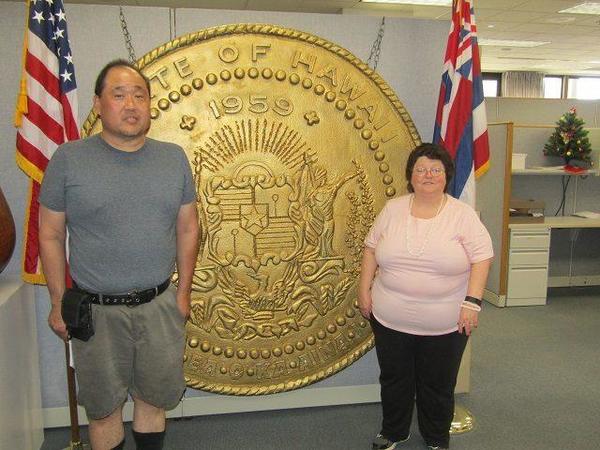 As far as the Hawaii State Capitol building itself, it’s located in downtown Honolulu, and was commissioned and dedicated by John A. Burns, second Governor of Hawaii. It opened on March 15, 1969, replacing the former statehouse, the ʻIolani Palace. It is the only open air capital of all 50 states. I love how they are all unique and have their own local touches. This one features volcano-shaped Legislative chambers as well as a large open central court area and tall supporting columns. There is a lot of symbolism represented in the building, but more on that in a bit.
As far as the Hawaii State Capitol building itself, it’s located in downtown Honolulu, and was commissioned and dedicated by John A. Burns, second Governor of Hawaii. It opened on March 15, 1969, replacing the former statehouse, the ʻIolani Palace. It is the only open air capital of all 50 states. I love how they are all unique and have their own local touches. This one features volcano-shaped Legislative chambers as well as a large open central court area and tall supporting columns. There is a lot of symbolism represented in the building, but more on that in a bit.
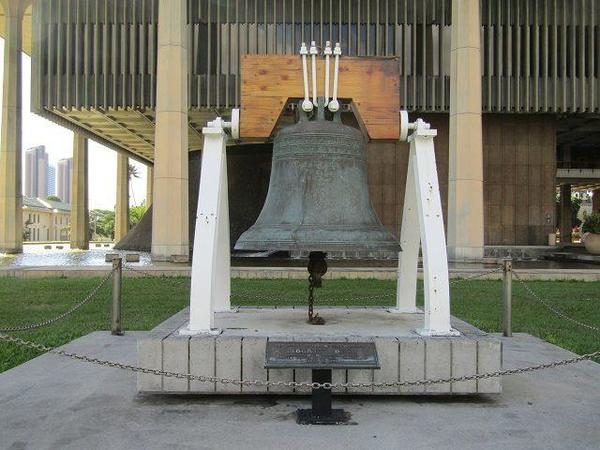 We started out the tour in the middle of the open-air rotunda area and learned that their state motto is Ua Mau Ke Ea O Ka Aina I Ka Pono, which means, The Life of the Land is Perpetuated in Righteousness. I thought that was pretty cool. While on the ground floor we saw the Liberty Bell that was given to Hawaii by the U.S. Treasury in 1950. Also in front of the capitol is a statue of Hawaii’s beloved Saint Damien who administered to the sick people of Kalaupapa on Molokai. One of the things I enjoyed most on the grounds was the amazing reflecting pool which surrounds the complex.
We started out the tour in the middle of the open-air rotunda area and learned that their state motto is Ua Mau Ke Ea O Ka Aina I Ka Pono, which means, The Life of the Land is Perpetuated in Righteousness. I thought that was pretty cool. While on the ground floor we saw the Liberty Bell that was given to Hawaii by the U.S. Treasury in 1950. Also in front of the capitol is a statue of Hawaii’s beloved Saint Damien who administered to the sick people of Kalaupapa on Molokai. One of the things I enjoyed most on the grounds was the amazing reflecting pool which surrounds the complex.
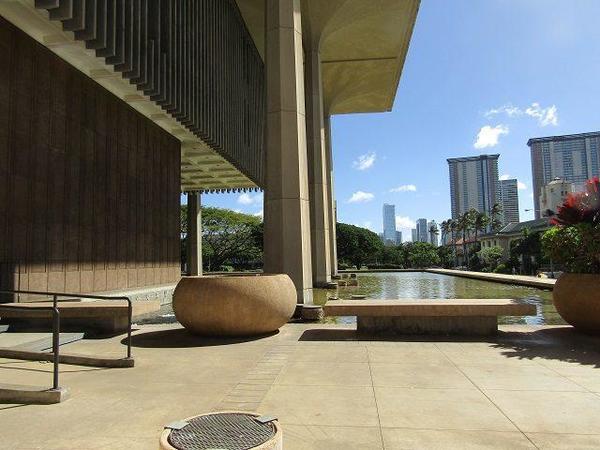 As we were walking around, our guide shared some of the distinct architectural features and various natural aspects of Hawaii that are visible throughout the capitol.
As we were walking around, our guide shared some of the distinct architectural features and various natural aspects of Hawaii that are visible throughout the capitol.
- The building is surrounded by a reflecting pool, symbolizing the Pacific Ocean.
- The two legislative chambers are cone-shaped, symbolizing volcanoes that formed the Hawaiian Islands.
- The columns around the perimeter of the building have shapes resembling royal palm There are eight columns in four rows at either side of the building, representing the eight main islands of Hawaii; sets of eight items appear in other places inside and along the outside of the building.
- The Capitol is built with an open-air design, allowing sun, wind, and rain to enter; the central atrium opens to the sky and rainbows can sometimes be seen inside the building when it rains.
- Four kukui nut trees are a numerical reference to the four main counties in the State of Hawaii. Sets of four items appear in many other places in the building.
- When standing in the center of the structure, the chandeliers from both legislative chambers, which represent the sun and moon, can be seen through the glass walls, while the area that is normally reserved for a rotunda in most capitol buildings is left open to the sky. It is said that the sky is Hawaii's capitol dome.
It was very interesting and we did see many sets of four and eight as we walked around the Hawaii State Capitol building.
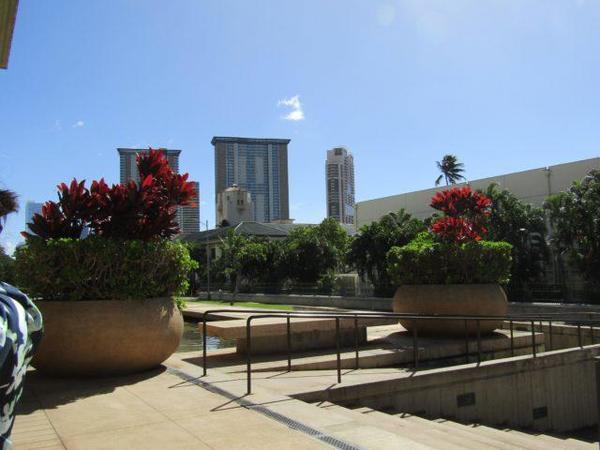 Also in the rotunda, and directly under the roof opening, is 36 foot circular mosaic, made of 600,000 Italian tiles, in various shades of blue. The hues represent the changing color and movement of the ocean as the sun, wind, tides and light reflect upon the surface. A note of interest was that the artist put in one red tile among all those blue. My husband Gene was the first one to find it! Good eye, lol.
Also in the rotunda, and directly under the roof opening, is 36 foot circular mosaic, made of 600,000 Italian tiles, in various shades of blue. The hues represent the changing color and movement of the ocean as the sun, wind, tides and light reflect upon the surface. A note of interest was that the artist put in one red tile among all those blue. My husband Gene was the first one to find it! Good eye, lol.
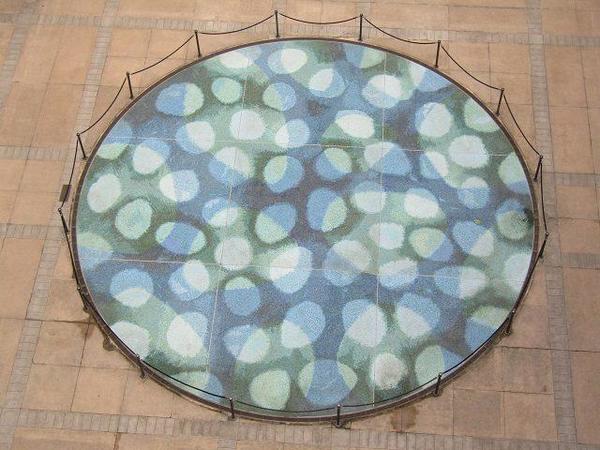 Anyway, before we left the main floor of the building, we saw the Senate and House of Representatives Chambers, but we couldn’t go in as they weren’t in session. They were starting sessions again about two weeks after our visit. Maybe next time we can catch them in session. Either way, we were able to see them through the glass windows and were able to take some pictures (even though they didn’t come out the great).
Anyway, before we left the main floor of the building, we saw the Senate and House of Representatives Chambers, but we couldn’t go in as they weren’t in session. They were starting sessions again about two weeks after our visit. Maybe next time we can catch them in session. Either way, we were able to see them through the glass windows and were able to take some pictures (even though they didn’t come out the great).
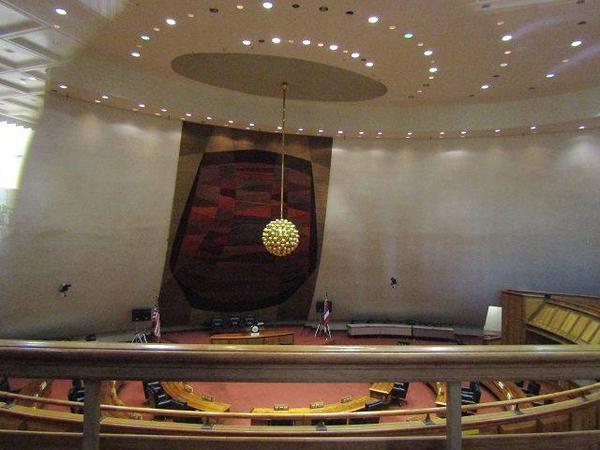 The rest of the Hawaii State Capitol was mostly offices and open space, but it was beautiful. Most of the wood was Koa and it was beautiful. I had never heard of Koa before, but I really like it. The other thing I wanted to mention was how thick the doors were to the Governor’s and Lt. Governor’s office. I noticed then when we walked in and couldn’t help but think how much effort it took to make them hang correctly. What a job!
The rest of the Hawaii State Capitol was mostly offices and open space, but it was beautiful. Most of the wood was Koa and it was beautiful. I had never heard of Koa before, but I really like it. The other thing I wanted to mention was how thick the doors were to the Governor’s and Lt. Governor’s office. I noticed then when we walked in and couldn’t help but think how much effort it took to make them hang correctly. What a job!
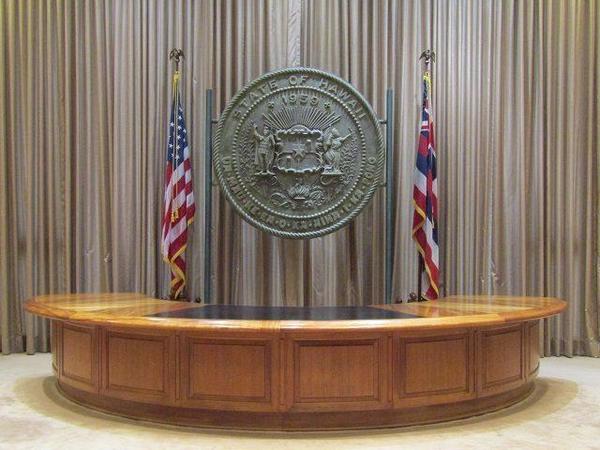 One of the last things we did on our tour was visit the Governors office and see where they do press conference and such. They had several smaller rooms with portraits of former Governors. It was quite impressive. Below is a picture of Mae (our tour guide) sharing information about a bowl made out of Koa. She was a very informative and great tour guide. Even after the tour she hung around and kept coming up to us and telling us more about the capitol and its history.
One of the last things we did on our tour was visit the Governors office and see where they do press conference and such. They had several smaller rooms with portraits of former Governors. It was quite impressive. Below is a picture of Mae (our tour guide) sharing information about a bowl made out of Koa. She was a very informative and great tour guide. Even after the tour she hung around and kept coming up to us and telling us more about the capitol and its history.
 I don’t think we could have had a better visit. If you are on Oahu, you should definitely take the time to visit the Hawaii State Capitol and learn more about the history of this amazing state. Here is a link to their website with more information and hours. Mahalo for reading about our trip.
I don’t think we could have had a better visit. If you are on Oahu, you should definitely take the time to visit the Hawaii State Capitol and learn more about the history of this amazing state. Here is a link to their website with more information and hours. Mahalo for reading about our trip.





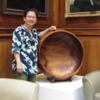



Comments (0)